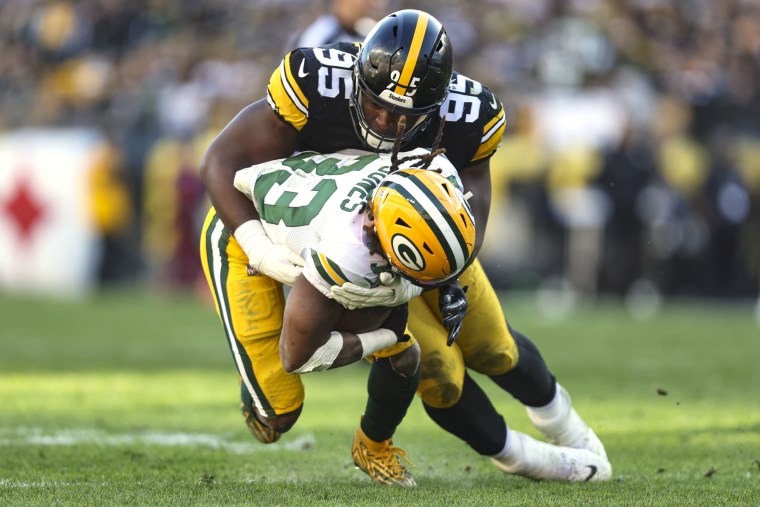NFL fans might have to start celebrating touchdowns with screams of “goooooal!”
That’s because touchdowns — football’s most crowd-pleasing, ball-spiking plays — are on a yearslong decline, making end zone incursions nearly as rare as soccer goals.
An average of 4.69 touchdowns have been scored per game through the first 10 weeks of the current season, according to an NBC News analysis of NFL data.
That’s more than one full TD less than the 5.75 per contest in 2020. From the 2013 to the 2021 seasons, touchdown averages had been relatively steady.
And this season’s touchdown rate would be even lower without a 12-TD extravaganza in Week 3, when the Miami Dolphins beat the Denver Broncos, 70-20, which tied for the second-most points ever scored in an NFL game.
If the trend continues, it would be the fourth consecutive season in which touchdowns declined.
There are plenty of theories for why.
Pro football historian Jon Kendle credits defensive coordinators for designing systems that allow for consistent gains by offenses but limit their shots at the end zone.
“Defenses have evolved to these high-powered offenses, and they’re saying, ‘Look we’re going to devise a scheme that’s going to allow you to go up and down the field,’” Kendle, vice president of museum and archives for the Pro Football Hall of Fame, told NBC News. “But then we’re going to shrink the field and hold you to a field goal or turn you over.”
Warren Sharp, an NFL analyst, had a similar take, writing in late October that defenses are doing better at limiting long plays and have received some help from the new interpretation and enforcement of rules.
One rule that has apparently hampered offenses is tight enforcement of the prohibition against offensive linemen getting head starts to block downfield on passing plays, Sharp said.
For years, referees appeared to turn a blind eye to the infraction, especially when the offender had no direct impact on action around the receiver. But tighter enforcement of that rule can ruin plays that call for quarterbacks to make late run-or-pass decisions.
And while crediting defenses, Sharp also takes offenses to task for conservative play-calling and poor pass protection.
“It’s easiest to point the blame to defenses and their adjustments. They’ve adapted the last two years and are playing a style of defense that has reduced big plays,” Sharp wrote. “But the offensive coordinators are not blameless themselves.”
In a recent segment on ESPN, former NFL quarterback Dan Orlovsky pointed to a new defensive strategy, “simulated pressure,” meant to confuse offensive lines and quarterbacks.
Orlovsky showed clips of a Kansas City Chiefs-Denver Broncos game, including one play when the Chiefs, the reigning champs, brought seven defenders to the line of scrimmage, looking like they were bringing pressure right up the middle.
But when the ball was snapped, many of those defenders peeled back. That led to three Denver offensive linemen blocking no one in the middle of the field and allowed pressure from the outside, leading to a strip sack.
“That simulation of walking those people up at the line of scrimmage creates a lot of chaos for an offense,” said Orlovsky, a well-regarded longtime analyst.
Aside from innovative defenses leading to the TD decline, another explanation could be the increasingly powerful legs of NFL placekickers.
So far this season, 25.9% of all scoring is coming from field goals, a number that has increased steadily in recent years. In 2020, it was 19.2%.
Just a generation ago, a 40-yard field goal was considered a challenge. In the 1989 season, 273 field goals were attempted from 40 to 49 yards, and 150 of them were good (54.9%).
So far this season, 162 tries from 40 to 49 yards have been attempted, with 131 conversions (80.9%).
And the “foot” of football was clearly on display this past weekend when six games were settled with field goals as time expired in regulation. They were the most walk-off kicks ever made in any single weekend in NFL history.
The dip in offense doesn’t make the game any less compelling, according to Kendle.
“These defensive coordinators and players are finding different ways to adjust. I see that as what’s happening in the last five years in the NFL, and to me, it makes it more exciting,” he said.
Football still hasn’t quite turned into soccer, but U.S. gridiron action is inching closer to the beautiful game in terms of TDs vs. goals.
There has been an average of 3.08 goals scored per match so far through the first third of the English Premier League season.

